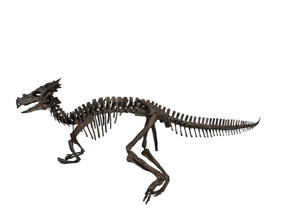A recent discovery of nearly complete skull along with several neck vertebrae of the Dracorex was discovered in the Hell Creek formation in Northwest South Dakota, USA in May 2003 and subsequently donated to The Children’s Museum of Indianapolis. The Children’s Museum referred to it as “a new type of dinosaur” that is “66-million-years-old” and “looks like a dragon”. The Children’s Museum displayed a placard next to a Dracorex image that read: “When we saw this creature’s head, we weren’t sure what kind of dinosaur it was. Its spiky horns, bumps and long muzzle looked more like a dragon”.

The name Dracorex hogwartsia comes from two very different sources. Dracorex, from the Latin meaning "dragon king" and hogwartsia from author J.K. Rowling’s (disturbing to us) "Harry Potter" series of books.
 |
| Adding wings to this skeleton does project the dragon imagery of China and medieval Europe. |
It is very possible, even highly likely, that many of the dragon legends that are known in some cultures are the distorted memories of when people lived with dinosaurs. However, in the case of Dracorex it seems that dragon legends may not have been greatly distorted from the real thing.
Normally, if historical experiences are not written down, but passed orally from generation to generation, errors creep in. The pattern over time is that experience becomes memory, memory becomes legend, and legend becomes myth.
Legends of dragons do imply that man once lived with dinosaurs and possibly with the Dracorex culminating with stories around them. Man do not create stories from looking at fossilized bones but from real experiences with the dinosaurs.
No comments:
Post a Comment